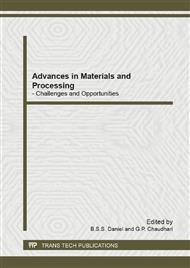[1]
A.A. Kamniskii, Laser crystals, second ed. Springer, Berlin. (1990) 252-253.
Google Scholar
[2]
E. Pacoraro, J.A. Sampaio, L.A.O. Nunes, S. Gama, M.L. Baesso, Spectroscopic properties of Water free Nd2O3 Doped Low Silica Aluminosilcate Glass, Non-Cryst. Solids. 277 (2000) 73-81.
DOI: 10.1016/s0022-3093(00)00316-1
Google Scholar
[3]
B. Viana, M. Palazzi, and O. LeFol, Optical characterization of Nd3+ doped sulphide glasses, Journal of Non-Crystalline Solids. 215 (1997) 96–102.
DOI: 10.1016/s0022-3093(97)00033-1
Google Scholar
[4]
L. Boehm, R. Reisfeld, N. Sepctor, Optical transitions of Sm3+ in oxide glasses, Journal of Solid State Chemistry. 28 (1979) 75-79.
DOI: 10.1016/0022-4596(79)90060-4
Google Scholar
[5]
B.T. Stone, K.L. Bray, Fluorescence properties of Er3+-doped sol-gel glasses, Journal of Non-Crystalline Solids. 197 (1996) 136-144.
DOI: 10.1016/0022-3093(95)00514-5
Google Scholar
[6]
R. Reisfeld, C.K. Jorgensen, Lasers and Excited States of Rare Earths, Springer, Berlin, (1977).
Google Scholar
[7]
Y.C. Ratnakaram, N.D. Thirpathi, R.P.S. Chakaradhar, Spectral studies of Sm3+ and Dy3+ doped lithium cesium mixed alkali borate glasses, Journal of Non-Crystalline Solids. 352 (2006) 3914-3922.
DOI: 10.1016/j.jnoncrysol.2006.06.008
Google Scholar
[8]
H. Choi, A. Margaryan, F. G. Shi, Judd-Ofelt analysis of spectroscopic properties of Nd3+doped novel fluorophosphate glass, Journal of Luminescence. 114 (2005) 167–177.
DOI: 10.1016/j.jlumin.2004.12.015
Google Scholar
[9]
I. Operea, H. Hesse, K. Betzler. Optical properties of bismuth borate glasses, Optical Materials 26(3) (2004) 235-237.
DOI: 10.1016/j.optmat.2003.10.006
Google Scholar
[10]
P. Becker, Thermal and Optical Properties of Glasses of the System Bi2O3-B2O3 Cryst. Res. Technol. 1 (2003) 74-78.
DOI: 10.1002/crat.200310009
Google Scholar
[11]
X. Zou, T. Izumitani Spectroscopic properties and mechanisms of excited state absorption and energy transfer upconversion for Er3+ doped glasses, J. Non-Cryst. Solids 162 (1) (1993) 68-80.
DOI: 10.1016/0022-3093(93)90742-g
Google Scholar
[12]
S. Tanabe, T Ohayagi, N Soga, et al. Compositional dependence of Judd-Ofelt parameters of Er3+ ions in alkali metal borate glass. Phys. Rev. B46 (1992) 3305-3309.
DOI: 10.1103/physrevb.46.3305
Google Scholar
[13]
B.R. Judd, Optical Absorption Intensities of Rare-Earth lons, Phy. Rev. 127 (1962) 750-761.
DOI: 10.1103/physrev.127.750
Google Scholar
[14]
G.S. Ofelt, Intensities of Crystal Spectra of Rare-Earth Ions, Chem Phys. 37 (1962) 511-519.
Google Scholar
[15]
W.F. Krupke, Induced-emission cross-section in neodymium laser glasses, IEEE J. Quantum electron QE-10 (1974) 450-457
DOI: 10.1109/jqe.1974.1068162
Google Scholar
[16]
W.T. Carnall, P.R. Fdcids, K. Rajnax, Electronic energy levels in the trivalent lanthanide aquo ions, The journals of Chemical Physics. 49(10) (1968) 4424-4432.
DOI: 10.1063/1.1669894
Google Scholar
[17]
A. Agarwal, I. Pal, S. Sanghi, M.P. Aggarwal, Judd-Ofelt Parameter and Radiative Properties of Sm3+ ions Doped Zinc Bismuth Borate Glasses, Opt. Mater. 32 (2009) 339-344.
DOI: 10.1016/j.optmat.2009.08.012
Google Scholar
[18]
M.J. Weber, Fluorescence and glass laser, J. Non crystal. Solids. 47 (1982) 117-134.
Google Scholar
[19]
S. Sanghi, I. Pal, A. Agarwal, M.P. Aggarwal, Effect of Bi2O3 on Spectroscopic and Structural Properties of Er3+ Doped Cadmium Bismuth Borate Glasses, Spectro. Chema Acta. 83 (2011) 94-99.
DOI: 10.1016/j.saa.2011.07.084
Google Scholar
[20]
I Pal, A. Agarwal, S. Sanghi, M.P. Aggarwal, Structural Absorption and Flurescence Spectral Analysis of Pr3+ ions Doped Zinc Bismuth Borate Glasses, Alloys Compds. 509 (2011) 7625-7631.
DOI: 10.1016/j.jallcom.2011.04.114
Google Scholar


